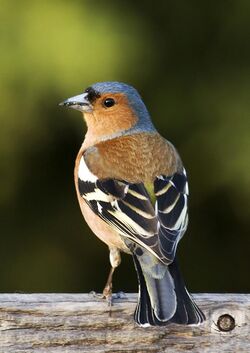Biology:Fringilla
| Fringilla | |
|---|---|

| |
| Male Eurasian chaffinch | |
| Scientific classification | |
| Domain: | Eukaryota |
| Kingdom: | Animalia |
| Phylum: | Chordata |
| Class: | Aves |
| Order: | Passeriformes |
| Family: | Fringillidae |
| Subfamily: | Fringillinae Leach, 1820 |
| Genus: | Fringilla Linnaeus, 1758 |
| Type species | |
| Fringilla coelebs Linnaeus, 1758
| |
| Species | |
| |
The genus Fringilla is a small group of finches from the Old World, which are the only species in the subfamily Fringillinae.
Taxonomy
The genus Fringilla was introduced in 1758 by the Swedish naturalist Carl Linnaeus in the tenth edition of his Systema Naturae.[1] The genus name Fringilla is Latin for "finch".[2] Linnaeus included 30 species in the genus (Fringilla zena was listed twice) and of these the Eurasian chaffinch (Fringilla coelebs) is considered as the type species.[3]
Species
The genus now contains eight species:[4]
| Image | Scientific name | Common name | Distribution |
|---|---|---|---|
 |
Fringilla coelebs | Eurasian chaffinch | Europe, across Asia to Siberia |
 |
Fringilla spodiogenys | African chaffinch | northwestern Africa |
 |
Fringilla moreletti | Azores chaffinch | Azores |
 |
Fringilla maderensis | Madeiran chaffinch | Madeira |
 |
Fringilla canariensis | Canary Islands chaffinch | Canary Islands |
 |
Fringilla polatzeki | Gran Canaria blue chaffinch | Gran Canaria, Canary Islands |
 |
Fringilla teydea | Tenerife blue chaffinch | Tenerife, Canary Islands |
 |
Fringilla montifringilla | Brambling | Europe, North Africa, northern India, northern Pakistan, China, and Japan |
The Eurasian chaffinch is found primarily in forest habitats, in Europe, North Africa, and western Asia; the blue chaffinches are island endemics; and the brambling breeds in the northern taiga and southern tundra of Eurasia.[5]
The eight species are about the same size, 15 centimetres (5.9 in) in length, and are similar in shape.[5] They have a bouncing flight with alternating bouts of flapping and gliding on closed wings.[6] They are not as specialised as other finches, eating both insects and seeds. While breeding, they feed their young on insects rather than seeds, unlike other finches.[5]
In 2016, it was proposed that the extremely rare Gran Canaria subspecies F. teydea polatzeki be treated as a separate species, thus creating a fourth species, F. polatzeki.[7][8]
References
- ↑ Linnaeus, Carl (1758) (in Latin). Systema Naturae per regna tria naturae, secundum classes, ordines, genera, species, cum characteribus, differentiis, synonymis, locis. 1 (10th ed.). Holmiae (Stockholm): Laurentii Salvii. p. 179. https://www.biodiversitylibrary.org/page/727086.
- ↑ Jobling, James A. (2010). The Helm Dictionary of Scientific Bird Names. London, United Kingdom: Christopher Helm. p. 164. ISBN 978-1-4081-2501-4. https://archive.org/details/Helm_Dictionary_of_Scientific_Bird_Names_by_James_A._Jobling.
- ↑ Paynter, Raymond A. Jr, ed (1968). Check-List of Birds of the World. 14. Cambridge, Massachusetts: Museum of Comparative Zoology. p. 203. https://www.biodiversitylibrary.org/page/14481404.
- ↑ Gill, Frank; Donsker, David, eds. "Finches, euphonias". World Bird List Version 5.2. International Ornithologists' Union. http://www.worldbirdnames.org/bow/finches/.
- ↑ 5.0 5.1 5.2 Newton, Ian (1973). Finches. New Naturalist 55. New York: Taplinger. pp. 19–30. ISBN 0-8008-2720-1.
- ↑ Clement, Peter; Harris, Alan; Davis, John (1993). Finches and Sparrows. Princeton, New Jersey: Princeton University Press. ISBN 0-691-03424-9.
- ↑ Sangster, G.; Rodríguez‐Godoy, F.; Roselaar, C.S.; Robb, M.S.; Luksenburg, J.A. (2016). "Integrative taxonomy reveals Europe's rarest songbird species, the Gran Canaria blue chaffinch Fringilla polatzeki". Journal of Avian Biology 47 (2): 159–166. doi:10.1111/jav.00825.
- ↑ "The Rarest Songbird in Europe". Wildlife Articles. http://wildlifearticles.co.uk/the-rarest-songbird-in-europe/.
External links
Wikidata ☰ Q581391 entry
 |

